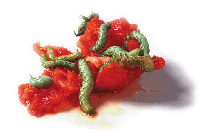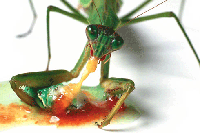ESSAYS
Writing I Tiik Pollet 12.10.2000
 http://www.catherinechalmers.com/foodchain.cfm
http://www.catherinechalmers.com/foodchain.cfm
Katherine Chalmer's "Food Chain"
There is a garden and a forest behind Broad Acres Elementary School where worms eat tomatoes, praying mantises eat worms, frogs eat praying mantises, snakes eat frogs and baby mice are at the mercy of any number of creatures, including their own mothers. Although the human traffic is less than at 19th and L streets NW at noon and the National Zoo on a weekday, it is still a peopled area with trails worn in from foot traffic through the favored shortcuts to the bike path that runs along the Paint Branch Creek. Somewhere along the line a human has inevitably witnessed a blip in the process of survival of the fittest, even if just to observe a maggot feast on a Bluejay carcass. I believe we know that insects, amphibians and mammals are engaged in a dance of life called the food chain. Some of us even have the awareness that this chain also includes humans.
Catherine Chalmers photo essay, “Food Chain” did not show me anything I have not already seen or teach me anything I did not already know about worms, praying mantises, frogs, snakes and mice in a natural or unnatural environment. I have watched worms munch down fruits and have gagged at finding a half worm in my own apple. I have captured praying mantises and frogs to keep them in jars and feed them bugs. I raised mice and watched their mothers eat them. My friend James fed baby mice to his snake during my visits to his basement apartment. No, I learned nothing new about nature and was not shocked, repelled or overjoyed with her subject matter.
Instead, I was delightfully surprised by the photographic feat she accomplished. The lighting she chose gave a soft edge to each subject, causing a sensual beauty. The stark white background is perfect for offsetting the vibrant reds of the tomato, pinks of the worm and mice, and greens of the frog, snake and praying mantis. In an unnatural environment she took a natural beauty hostage and captured it on film. It would take hours, days and years to develop the ability to see the sensual side of these food chain behaviors in a natural environment. One would need to virtually become “one” with nature and experience a mental/emotional transformation.
Chalmer has skipped all the natural processing formalities of observation. I am fascinated by her ability to use the unnatural to show the natural. There is a worm eating a tomato. We don’t smell the rot or experience any of the sensory discomforts of being there. We just look at the beautifully crafted, colorful representation of a worm enjoying dinner. A praying mantis sits on a smiling frogs head. Are they friends? My human arrogance tempts me to believe they are. Is the frog really smiling the way I experience human smiles or is it just her face? Common sense tells me it is just her face, although she may be thrilled at the moment, considering she has a tasty bug on her head.
I have seen National Geographic photos of animals in similar situations, filmed in the wild and have not been as moved by them. The stark white background suggests an artists palette, a human element. I adore this aspect of Chalmer’s photo essay. She has borrowed creatures from their natural environments, fed them well and they have shown their gratitude by posing for her canvas.
top